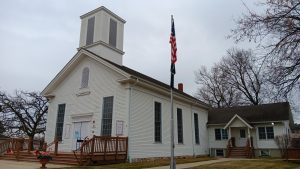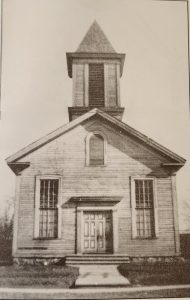Former Antioch church receives landmark status
By Gregory Harutunian for Chronicle Media — January 16, 2024
The “Meeting House” was built in 1863, and is the oldest existing structure in Antioch. Used primarily as a church, the Lakes Region Historical Society purchased the building and grounds in 2000. (Photo by Gregory Harutunian/for Chronicle Media)
A “meeting house” built by the Disciples of Christ for their services near downtown Antioch, during the Civil War years, has been recognized for its importance to the village. Not only did the congregation give the village its name, but the building has stood relatively unchanged since 1863, at the same location.
The Village Board unanimously passed an ordinance designating the white clapboard structure as the first individual landmark in Antioch, during its Dec. 13 session. It is also the oldest free-standing building in the town that can be documented.
“It’s a unique property … not only for its history, its integrity, and its architectural perspective as a prime example of a Greek revival style,” said Michael Garrigan, the village’s community development director. “It’s entirely appropriate that the oldest existing building in Antioch be designated as our first individual landmark.”
The Antioch Historical Preservation Commission had previously given a unanimous vote for the measure. The Lakes Region Historical Society purchased the building and property in 2000, when it became available, as well as the adjoining properties to the north and south.

The “Meeting House” as it appeared in the late 1920s, with a bell tower added, which has since been removed. (Photo courtesy of Lakes Region Historical Society)
The nonprofit group set about restoring the building to its original condition, removing a stucco exterior and bell tower that had been added through the years. Used as a place of worship for most of its existence, the Disciples of Christ erected the original building at 977 Main St., after emigrating from New York.
“The intent was to resemble church styles in New England, and they formed near here in the 1840s,” said Ainsley Wonderling, the historical society’s director. “British settlers wanted to name the town Windsor, while the Disciples of Christ wanted Antioch, after the biblical place where the original disciples were first named Christians.
“My family goes back many generations in Antioch, and this was my family’s church from inception, with my ancestors building it. There are extensive county biographies with information, It was an Episcopal parish from 1915-2000. In 1926, they added the Cali Stone stucco, stained glass windows, and the bell tower.”
The congregation decided to move in 2000, with the building coming up for sale. The society’s purchase coincided with receiving one-quarter of the Dolly Spiering Fund, a local grant meant to continue a thriving legacy of assisting in medical concerns, historic preservations, and taking care of senior residents.
When the society sought to begin restoration, they turned to one of their founding members, Earl Beese, a shop teacher and mechanical engineer. He drew up the plans and documented the steps, winning an “Award of Excellence” from the Illinois Association of Museums in Springfield for the efforts.
The work yielded surprises that were hidden for more than a century.
“He kept meticulous records, and wrote a book detailing this,” said Wonderling. “You can still see along the walls, where the original pew benches were located. There was a choir loft over the door, too. Also, in a floor joist, there was actually a tank for baptisms, a water container for immersions, and a pipe was uncovered outside that filled it.
“In the back hall, where Sunday School was held, walls were covered over by paneling,” she said. “When they were removed, we found signatures of the kids signed on the wall. This was a community place. They had turkey dinners during October harvest time, dancing lessons, square dancing … just a thriving gathering spot.”
The historical society is keeping its archives in the building, and currently operates the meeting house as a museum.
“I’m thrilled the board has taken action to recognize the ‘meeting house’ as its first individual landmark in the village,” said Scott Gartner, Antioch’s mayor. “This process also recognizes the historical significance to the residents, and future generations of our town.”







